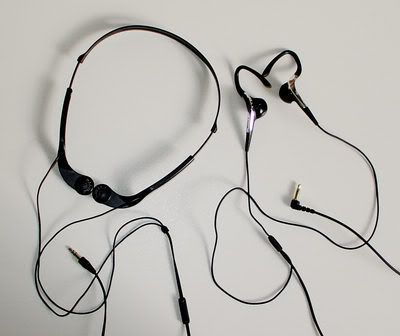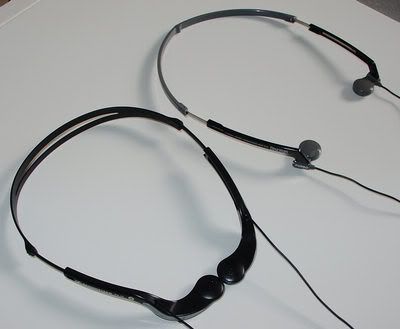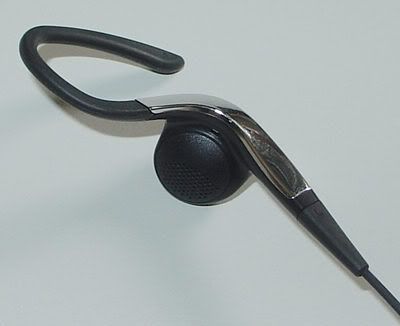
PX10 on the left, MDR-J20 on the right.
Both the J20 and the PX10 are ‘partially in the ear phones’. These take a regular earphone speaker and turns it 90 degrees so that part of the speaker assembly is almost inside the ear canal at an oblique angle when worn. Pioneered on the ‘Turbo’ Sony sports earphones more than a decade ago, this increases the stability of fit for active types, and also delivers more bass into the ear than loosely coupled regular earphones.
DESIGN/FIT

The PX10 is a headbanded ‘partially in the ear’phone, very much like the original ‘Turbo’ phones. The engineering is however in some ways a retrograde step to the ‘Turbo’. The lightweight all-plastic construction doesn’t provide enough ‘spring’ in the headband to exert sufficient pressure to give a solidly secure fit and contributes to a feeling of floppy fragility, and it doesn’t fold. Lookswise, it’s rather more sculptured than the ‘Turbo’ bringing the look up to date. And finally, it adds an additional feature which will undoubtedly come in handy for runners: An MX500-style sliding volume control just below the symmetrical Y-split in the cable. The slider control is however pretty on/off. There’s not a smooth transition in volume, rather a series of uneven steps of large cuts. I would expect that the precise behaviour of the volume control will vary in individual examples due to the cheapness of the sliding potentiometer. The 3.5mm mini plug is nickel plated.

Closeup of the MDR-J20 (Left side).
The Sony MDR-J20 is a slightly more imaginative take on the original ‘Turbo’. Instead of a headband, it uses earhooks to retain the phones in the ears. So it is compact and definitely easier to stow than the PX10. The look is very contemporary and well executed. They manage, thanks to the shape and the silver accent to be pretty discreet but a definite ‘style point’. The hooks successfully hold the J20 in place during most activities… but it is easier to pull these out than the PX10, due to the lack of a headband and also the shape of the part that goes inside the ear. The J20 adopts Sony’s common asymmetrical cable arrangement, with the cable for the right ear going behind the neck, joining the left cable on that side. The super-low-profile right angled 3.5mm plug is gold plated. The phone is available in silver/black as above and also white.
Both are subjectively equally comfortable to wear due to their light weight and the way they sit fairly unobtrusively in the ear. However the PX10 with a higher cable attachment point and the Y-split does allow the cable to be potentially more intrusive. The J20 works with bicycle helmets and other protective headgear, while the PX10 can do to a degree but is not comfortable when used in such a situation.
SOUND
As with practically any earphone of this type, fit does control sound to a degree, although as said before with much less variability than regular style earphones. When hung lightly on the ear these give the best sound clarity. When pushed into the ear canal for a more secure fit, both phones become murkier (for the obvious reason that the start of the ear canal would ‘plug up’ the holes where the sound comes out of). The Sony’s exhibited far more potential degredation in this respect. For the purposes of sound quality measurement, the evaluations were made by sitting the phones at a point where they were securely fitting and would remain so, but exhibited the least impeded sound. Both phones had sufficiently high efficiency to be powered by the ~5mw/channel output of the Sony HD5. Neither provides isolation as such, but the Sony when pushed into the ear gave a more pronounced blocking of outside noise.
Both are more secure in fit than regular earphones, and both do provide a more balanced sound on the move. If you just want background music and just want something unobtrusive that stays in place while jogging or whatever, the Sony MDR-J20 is not a bad choice, especially as you can just wad it up for storage unlike the PX10. Subjectively speaking, the Sony also looks smarter on the head. However the Sennheiser is nearly as unobtrusive in actual use and a clearly better sounding item. A case of horses for courses...
PRODUCT LINKS:
Sennheiser PX10
Sony MDR-J20 (silver)
No comments:
Post a Comment